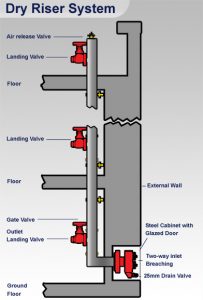Dry Risers are vertical mains often fitted into staircase enclosures or other suitable positions. They have outlet valves on each floor and inlets at ground level to enable the fire brigade to connect to the water supply.
Where are Dry Risers found?
Dry Risers can be found in buildings over 18metres above ground level or in low level buildings where there are excessive distances from entrances.
What does a Dry Riser look like?
Typical Dry Risers contain the following components:
– A large vertical pipe that can run internally or externally to the building
– Twin/four-way inlet connection at street level boxed in a steel cabinet with a glazed door
– Outlet valves at each landing
– Automatic air release valve at the highest point to provide bleeding of air from the system when it is filled with water
Why do Dry Risers escape close inspection?
Dry Risers are an integral part of the building fabric; therefore, they are often overlooked as they are built in behind the internal walls. The inlet and outlet valves are often house in cabinets and cupboards which are often locked so often overlooked.
If you have a Dry Riser on your premises, it is your responsibility to make sure it is properly maintained. If you move into a new premise with a Dry Riser which looks like it has been forgotten about, you should get it inspected as soon as you can.
At Total Safe, we make the whole process easy and economical, keeping you updated and informed every step of the way.
A fully qualified Total Safe engineer will perform a visual inspection of the Dry Riser itself. They will then cordon off any areas affected by the dry riser testing. The system is then charged with water and monitored to ensure the pressure is maintained over time and distance. After the test is complete, the pipework is drained, and the cabinets are closed and safely locked.
For more information on dry riser testing and dry riser maintenance contact Total Safe UK.
